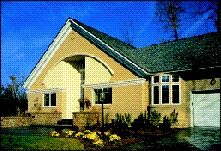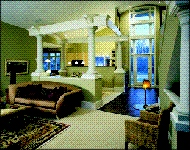Just looking at a piece of lumber and then a concrete masonry block makes it clear why concrete homes are more energy efficient than wood-frame homes. Concrete’s mass slows down the passage of heat moving through the wall. This means that, with the same insulation, a concrete home stays warmer in the winter and cooler in the summer than a wood-frame home. Also, a concrete wall doesn't have as many air leaks as a wood-frame wall - and air leakage accounts for a large percentage of energy loss in the home.
 A concrete home can keep you comfortable year-round... while reducing your utility bills.
A concrete home can keep you comfortable year-round... while reducing your utility bills.
Besides having the advantage of mass, today's concrete home building systems all utilize cost effective, highly efficient insulation to keep your home comfortable year round while enjoying the benefits of lower utility bills.
Solid Construction
Concrete forms an integral wall - solid, continuous and airtight. By comparison, a wood-frame wall is a collection of components - studs, sheet rock, sheathing and insulation. Each joint and connection is a potential air leak. As the air passes through these leaks, it takes heating and air conditioning with it.
Space Age Insulation
Today's concrete home benefits greatly from the progress that has been made in home insulation during the past 20 years. Many insulated concrete wall systems use polystyrene blocks or panels as the concrete formwork into which reinforcing steel and concrete are placed. These polystyrene forms are left in place to give your home an exceptional R-value. For concrete masonry homes, insulation choices range from foiled backed batts to polystyrene panels. Standard hollow masonry units can be filled with insulating materials.
Smart Design = Savings
When designing today's concrete home, smart builders are able to realize considerable savings by using concrete's energy efficiency to justify smaller heating and air conditioning systems. This results in a comfortable home with correspondingly smaller heating and air conditioning bills. The bottom line - savings are realized up front and throughout the life of a home.

Concrete homes are more energy efficient than wood-frame homes.
U.S. Green Building Council New LEED Product
Concrete Contributions to LEED v4 focuses on the inherent properties of concrete. This June 13, 2013, article highlights credits in LEED v4 to which concrete may contribute. Concrete’s characteristics of low albedo, thermal mass, recyclability, local availability, lack of volatile organic compounds (VOCs), and the industry’s transparency can all contribute to more sustainable projects.
That's The Beauty of Today's Concrete
There's more than one way to build your concrete home - insulating concrete forms, concrete masonry, aerated concrete, tilt-up concrete, or precast concrete to name a few. With volatile wood prices, logging's high environmental price tag, and a growing shortage of high quality lumber, concrete offers a variety of products and construction techniques to provide cost effective, quality alternatives to wood-frame home construction.
All of these systems share the same basic virtues of concrete - beauty, strength, durability, low maintenance, energy efficiency, interior environmental quality, environmental friendliness, and peace and quiet. Which concrete building technique is right for you depends on the labor force and predominant building practices in your area. Whatever your choice, you can rest assured that your beautiful concrete home is built to last.